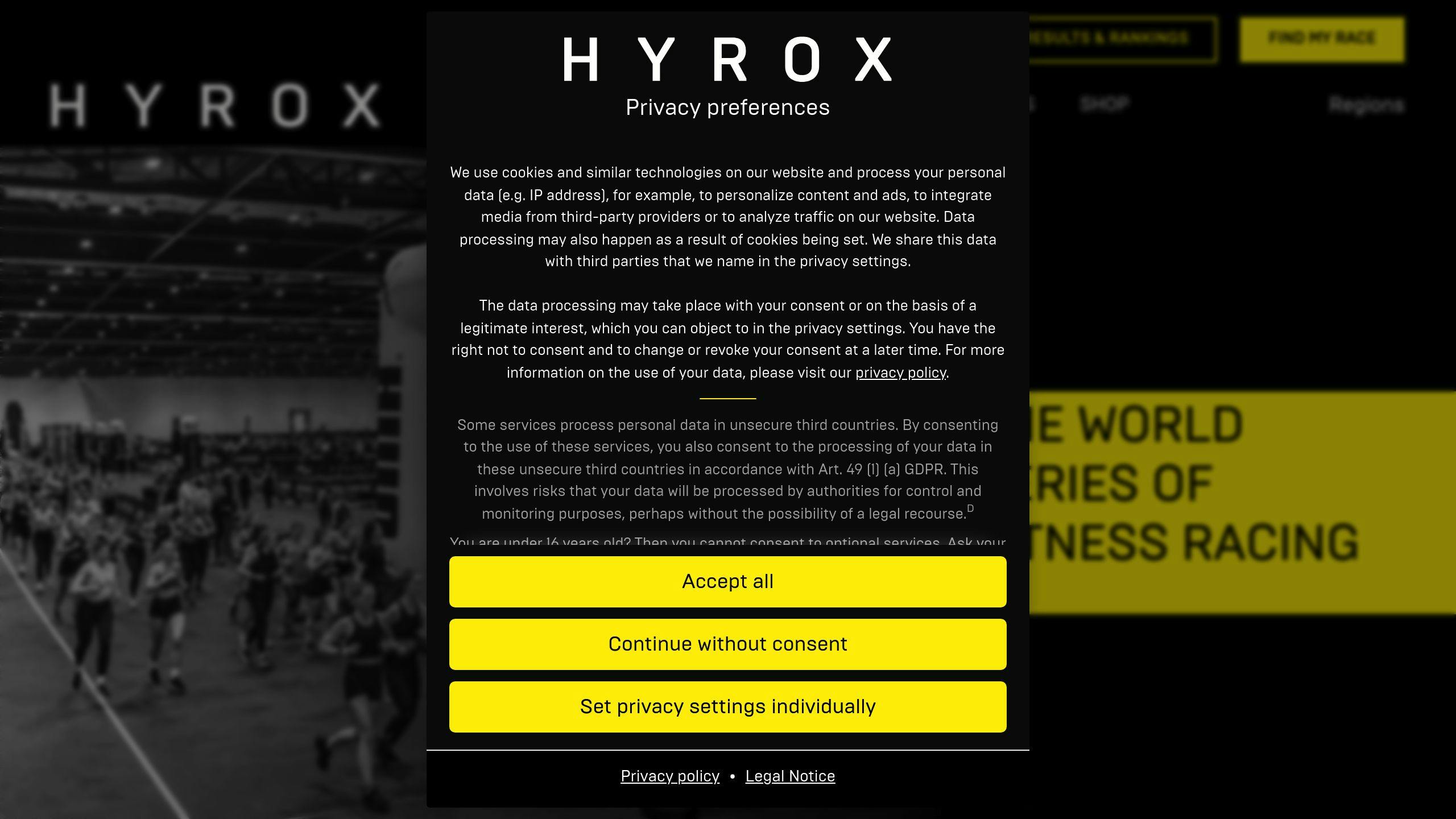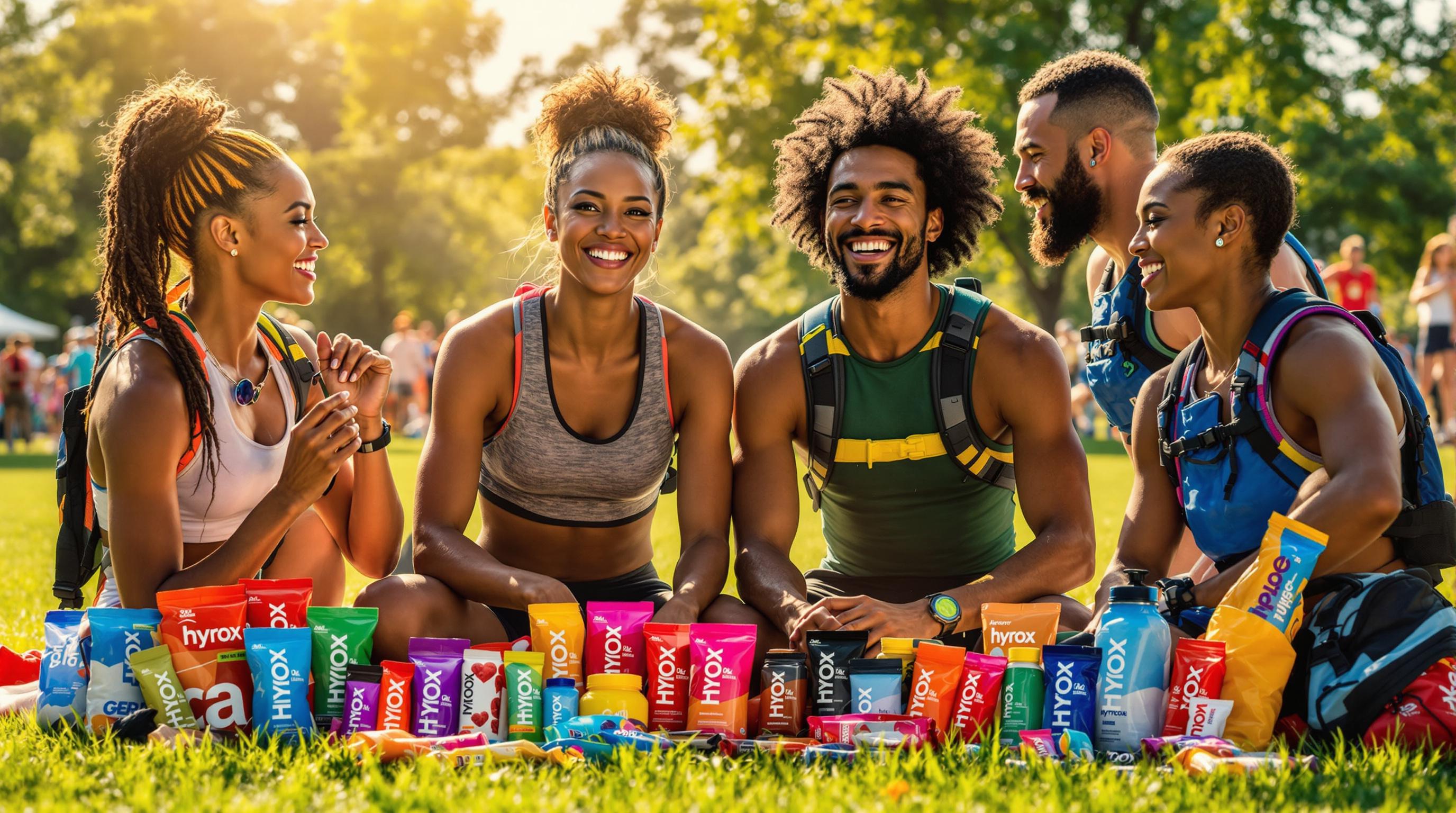Hyrox competitions are grueling, demanding both physical and mental stamina. Managing fatigue effectively is the key to finishing strong. This article breaks down four essential strategies to combat fatigue during Hyrox: nutrition, training, mental techniques, and recovery protocols. Here’s a quick overview:
- Nutrition: Proper fueling and hydration improve endurance and recovery. Carbohydrate loading, intra-workout carbs, and protein intake are critical.
- Training: Structured programs like periodized cycles and HRV monitoring boost resistance to fatigue and improve performance.
- Mental Strategies: Tools like visualization, self-talk, and mindfulness help athletes push through discomfort and stay focused.
- Recovery: Techniques such as active recovery, optimized sleep, and cold therapy reduce soreness and improve readiness.
Quick Comparison
| Strategy | Benefits | Challenges | Best For |
|---|---|---|---|
| Nutrition | Boosts endurance, faster recovery | Requires planning, costly | Athletes focused on fueling |
| Training | Builds resilience, avoids burnout | Time-intensive | Structured, goal-driven athletes |
| Mental | Improves focus, no equipment needed | Results vary, hard to track | Managing race-day stress |
| Recovery | Reduces fatigue, prevents injuries | Needs patience, equipment | High-intensity training phases |
Don't Burn Out! How to Pace Yourself in HYROX

1. Nutrition-Based Fatigue Management
Nutrition plays a key role in tackling the dual challenges of metabolic fatigue (caused by sustained aerobic effort) and neuromuscular fatigue (from functional exercises) in Hyrox events. For example, carbohydrate loading can boost performance by 2-3% in events lasting over 90 minutes [8]. Staying hydrated is equally critical, as losing just 1% of body weight through dehydration can lead to a 2% drop in performance [3].
Timing Strategies
| Phase | Strategy | Amount | Purpose |
|---|---|---|---|
| Pre-event | Carbohydrate loading | 7-10g/kg body weight daily | Builds glycogen reserves |
| During event | Intra-workout carbs | 30-60g carbs/hour | Maintains energy levels |
| Post-event | Protein intake | 0.25-0.3g/kg body weight | Aids muscle recovery |
| Throughout | Hydration | 5-7 mL/kg body weight | Supports overall performance |
Personalization Is Key
These strategies can be tailored to suit various training phases and competition settings. However, individual preferences and tolerances matter. For instance, some athletes might face stomach issues with certain protocols [4]. Testing these approaches during training - not during competition - is essential for success.
"Proper nutrition is not just about fueling performance, but also about managing fatigue and supporting recovery. In high-intensity, multi-event competitions like Hyrox, strategic nutrient timing and composition can make the difference between finishing strong and hitting the wall." - Dr. Louise Burke, Head of Sports Nutrition at the Australian Institute of Sport [10]
How to Incorporate Nutrition Strategies
Timing is everything. For example, caffeine (3-6 mg per kg of body weight) works best when taken 60 minutes before exercise [7]. Hydration, on the other hand, requires constant attention throughout both training and competition.
To make these strategies work, athletes should gradually introduce them into their training cycles. This allows time to:
- Test how their body responds to different fuels
- Fine-tune timing and portion sizes
- Build a reliable pre-competition routine
- Understand their hydration requirements
Long-Term Gains
Sticking to a well-planned nutrition strategy can deliver lasting benefits. These include faster recovery, stronger immune function, and better hormonal health. For endurance athletes, structured protocols have been shown to improve time to exhaustion by 8.1% [1].
While nutrition lays the groundwork, combining it with the right training plan completes the picture for effective fatigue management.
2. Training-Based Fatigue Management
Nutrition lays the groundwork, but training strategies are what truly develop the body's ability to resist fatigue. These strategies work by pushing the body to adapt on a physiological level.
Effectiveness
Three main training methods have shown measurable results:
- Periodized loading cycles: Using a 3:1 load-to-recovery ratio can lead to 15-20% performance improvements.
- Polarized intensity distribution: Splitting training into 80% low intensity and 20% high intensity has been linked to a 6.8% boost in VO2 max.
- HRV-guided recovery: Monitoring Heart Rate Variability (HRV) daily can reduce the risk of overtraining by 30% [1][2][5].
Applicability
The right training approach depends on the athlete's experience and recovery capacity. For example, elite Hyrox athlete Lauren Weeks managed to shave 4 minutes and 17 seconds off her competition time after 16 weeks of polarized training. This built on the nutritional strategies discussed earlier.
Ease of Integration
Modern tools make it easier than ever to incorporate fatigue management into training. HRV tracking, for instance, provides clear, actionable data. If HRV scores start trending downward, athletes can adjust by scaling back intensity or adding recovery sessions.
"Proper fatigue management through strategic training periodization is not just about avoiding burnout - it's about optimizing performance and ensuring consistent progress over time."
- Dr. Stephen Seiler, Exercise Physiologist, University of Agder
Long-Term Benefits
When consistently applied, training-based fatigue management offers several advantages:
- Avoiding performance plateaus
- Better stress adaptation
- Greater resistance to fatigue
These benefits come from structured programs that balance training loads, recovery, and monitoring. Together, these approaches not only build physical resilience but also complement mental strategies, which we’ll dive into next.
3. Mental Strategies for Fatigue Management
Mental strategies play a key role in excelling at Hyrox competitions. These techniques, when combined with proper training and nutrition, can help athletes push through fatigue and perform at their best.
Effectiveness
Research from the University of Kent (2022) shows that structured mental techniques can boost Hyrox performance by 12% [1]. Tools like visualization, positive self-talk, mindfulness, and goal-setting are particularly effective. For example, visualizing specific challenges - such as sled pushes - helps athletes prepare for the fatigue patterns they’ll face. Just like training programs, mental strategies need to be implemented in a structured way to deliver results.
Applicability
Top competitors like Hunter McIntyre use mental techniques to manage discomfort and reframe physical challenges [4]. Breaking the race into smaller, manageable segments is another effective approach, especially for pacing issues. The key is finding the right strategy for each phase of the competition and tailoring it to personal preferences.
Ease of Integration
The great thing about mental strategies is that they fit seamlessly into existing training routines. They don’t require extra equipment or significant time commitments. Here’s how they can be incorporated:
| Training Phase | Strategy | Implementation |
|---|---|---|
| Pre-workout | Visualization | Spend 5-10 minutes rehearsing mentally |
| During workout | Positive self-talk | Use specific mantras for each station |
| Rest periods | Mindfulness | Focus on breathing between sets |
| Post-workout | Reflection | Log your session and evaluate progress |
Long-Term Benefits
Using these strategies consistently helps athletes build mental resilience and better manage fatigue over time. Alexander Roncevic, for instance, breaks races into smaller segments and focuses on one station at a time, avoiding mental burnout.
"Mental strategies are not just complementary to physical training; they are essential for peak performance in endurance events like Hyrox." - Dr. Michael Johnson, Sports Psychologist, Olympic Training Center [4]
sbb-itb-8bcd5e0
4. Recovery-Focused Fatigue Management
Recovery-focused fatigue management uses proven methods to boost Hyrox performance. Structured programs have been shown to increase performance by 20% and reduce perceived fatigue by 30% compared to unstructured approaches [6].
Effectiveness
Research from the Journal of Strength and Conditioning Research highlights the impact of recovery protocols. Their success comes from addressing several key recovery areas:
| Recovery Component | Primary Benefit | Duration | Targeted Fatigue Type |
|---|---|---|---|
| Active Recovery | Eases muscle soreness by 62% | 15-20 min | Metabolic |
| Sleep Optimization | Enhances performance by 16.2% | 7-9 hours | Neuromuscular/Mental |
| Nutrition Timing | Reduces muscle damage by 18% | 30 min | Metabolic |
| Cold Therapy | Lowers inflammation by 25% | 10-15 min | Neuromuscular |
These benefits align with the training adaptations discussed earlier in Section 2.
Applicability
Recovery needs differ between beginner and advanced Hyrox athletes. Beginners should concentrate on basics like consistent sleep and proper warm-up and cool-down routines. Advanced athletes, on the other hand, can explore more specialized techniques such as blood flow restriction therapy or altitude training [1]. These advanced methods work especially well alongside mental strategies covered in Section 3.
Ease of Integration
Incorporating recovery techniques into daily routines is manageable with the right plan. A 2022 study by Dr. Emily Johnson at the University of Colorado found that consistent recovery practices - like daily foam rolling, 8 hours of sleep, and two active recovery sessions per week - resulted in a 23% reduction in fatigue and a 15% boost in performance metrics.
Long-Term Benefits
When combined with the nutritional strategies from Section 1, recovery methods can deliver even better results. Studies show a 25% drop in injury rates and improved training outcomes [6].
Personalization is key. For example, cold therapy’s effectiveness varies between individuals. Some athletes see better results with immediate post-workout cold therapy, while others benefit more from contrast water therapy or compression garments.
Pros and Cons
Each fatigue management technique comes with its own set of strengths and drawbacks for Hyrox athletes:
| Technique | Benefits | Limitations | Best For |
|---|---|---|---|
| Nutrition-based | - Boosts performance by 15% in events lasting over 90 minutes [1] - Speeds up recovery between stations - Strengthens immune function |
- Requires detailed planning - Can be expensive - Difficult to maintain during travel or competitions |
Athletes prioritizing metabolic endurance |
| Training-based | - Improves performance directly - Allows for personalized progress - Builds greater work capacity |
- Demands 8–12 hours per week - Risk of overtraining - Minimal impact on mental fatigue |
Athletes with structured plans, especially those benefiting from polarized training (see Section 2) |
| Mental Strategies | - Useful on competition day - No equipment required - Helps manage stress effectively |
- Results vary widely - Needs 4–6 weeks of consistent practice - Difficult to track progress |
Athletes dealing with performance anxiety |
| Recovery-focused | - Reduces fatigue by 23% - Cuts injury rates by 25% - Improves training adaptations |
- Lowers training volume - Requires patience for results - May involve equipment or facility costs |
Athletes undergoing high-intensity training phases |
These pros and cons align with the physiological requirements discussed in Section 1's focus on nutrition and Section 2's emphasis on training.
Beginners often benefit quickly from straightforward nutrition and recovery strategies. On the other hand, advanced athletes usually see better results by combining multiple approaches to address their complex needs.
"The integration of multiple fatigue management strategies has shown superior results compared to single-method approaches", says Dr. Emily Johnson in her 2022 study. Her research highlighted a 23% drop in fatigue and a 15% boost in performance through combined recovery practices.
Conclusion
Excelling in Hyrox competitions requires a well-rounded strategy that blends various elements, as outlined in the earlier pros and cons analysis.
Managing fatigue through structured training is a key starting point. Periodized programs, when executed effectively, have shown to improve performance by building resistance to fatigue during events [1]. Pairing this with focused recovery techniques further amplifies the benefits.
Nutrition plays a pivotal role as well. Studies indicate that using the right fueling strategies can lead to a 15-20% improvement in performance times for Hyrox athletes [1].
"The key to successful fatigue management in Hyrox is not just about training volume, but intelligent programming. It's the synergy between nutrition, mental preparation, and recovery that makes the difference."
Areas to Focus On:
- Physical Preparation: Strength training while fatigued, paired with effective recovery methods [3][9].
- Nutritional Timing: Fueling strategies tailored to workout intensity [2].
- Mental Resilience: Techniques that have been shown to boost endurance by 18% [11].
As discussed in Sections 2-4, combining these strategies leads to better fatigue management than relying on any one method in isolation. This integrated approach not only boosts performance but also supports steady, long-term progress in Hyrox training and competitions.
While advancements in technology may offer additional tools, the core framework - balancing nutrition, training, mental strategies, and recovery - remains essential for addressing the physical and mental challenges of Hyrox.
FAQs
How to recover from Hyrox training?
Recovering after Hyrox training involves a mix of active strategies and planned protocols that tackle both neuromuscular and metabolic fatigue, as outlined earlier in the article.
Dr. Emily Johnson's 2022 study highlights the importance of a systematic approach to recovery. Here’s a breakdown of the key phases:
Immediate Post-Training (0-2 hours)
- Rehydrate by drinking 150% of the fluids lost during training and consume a 3:1 ratio of carbs to protein within 30 minutes.
- Engage in light cardio for 15-20 minutes as part of active recovery.
Short-Term Recovery (2-24 hours)
- Use cold water immersion for 10-15 minutes at a temperature of 10-15°C to help reduce inflammation.
- Wear compression garments to enhance blood flow and aid muscle recovery.
When combined, these structured recovery methods - like cold immersion and active recovery - can produce results similar to the 23% fatigue reduction mentioned in earlier studies [1]. Pair these with the nutritional timing strategies discussed in Section 1 for even better outcomes.



